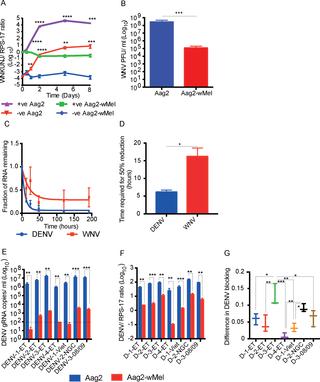PLoS Pathogens ( IF 5.5 ) Pub Date : 2018-03-01 , DOI: 10.1371/journal.ppat.1006879 Saijo Thomas , Jiyoti Verma , Megan Woolfit , Scott L. O’Neill

|
Wolbachia is currently being developed as a novel tool to block the transmission of dengue viruses (DENV) by Aedes aegypti. A number of mechanisms have been proposed to explain the DENV-blocking phenotype in mosquitoes, including competition for fatty acids like cholesterol, manipulation of host miRNAs and upregulation of innate immune pathways in the mosquito. We examined the various stages in the DENV infection process to better understand the mechanism of Wolbachia-mediated virus blocking (WMVB). Our results suggest that infection with Wolbachia does not inhibit DENV binding or cell entry, but reduces virus replication. In contrast to a previous report, we also observed a similar reduction in replication of West Nile virus (WNV). This reduced replication is associated with rapid viral RNA degradation in the cytoplasm. We didn’t find a role for host miRNAs in WMVB. Further analysis showed that the 3’ end of the virus subgenomic RNA was protected and accumulated over time suggesting that the degradation is XRN1-mediated. We also found that sub genomic flavivirus RNA accumulation inactivated XRN1 in mosquito cells in the absence of Wolbachia and led to enhancement of RNA degradation in its presence. Depletion of XRN1 decreased WMVB which was associated with a significant increase in DENV RNA. We also observed that WMVB is influenced by virus MOI and rate of virus replication. A comparatively elevated blocking was observed for slowly replicating DENV, compared to WNV. Similar results were obtained while analysing different DENV serotypes.
中文翻译:

蚊子细胞中的Wolbachia介导的病毒阻断取决于XRN1介导的病毒RNA降解并受病毒复制速率的影响
Wolbachia目前正被开发为一种新型工具,以阻止埃及伊蚊传播登革热病毒(DENV)。已经提出了许多机制来解释蚊子中的DENV阻断表型,包括争夺胆固醇等脂肪酸,操纵宿主miRNA以及蚊子中固有免疫途径的上调。我们检查了DENV感染过程的各个阶段,以更好地了解Wolbachia介导的病毒阻断(WMVB)的机制。我们的结果表明感染了沃尔巴克氏菌不会抑制DENV结合或细胞进入,但会减少病毒复制。与以前的报告相比,我们还观察到西尼罗河病毒(WNV)复制的减少类似。这种减少的复制与细胞质中病毒RNA的快速降解有关。我们没有发现WMVB中宿主miRNA的作用。进一步的分析表明,病毒亚基因组RNA的3'端受到保护并随时间累积,表明该降解是XRN1介导的。我们还发现在没有沃尔巴克氏菌的情况下,亚基因组黄病毒RNA积累使蚊子细胞中的XRN1失活。并在存在RNA时导致RNA降解增强。XRN1的减少减少了WMVB,这与DENV RNA的显着增加有关。我们还观察到WMVB受病毒MOI和病毒复制速率的影响。与WNV相比,观察到缓慢复制的DENV相对较高的阻断作用。分析不同的DENV血清型时,获得了相似的结果。











































 京公网安备 11010802027423号
京公网安备 11010802027423号